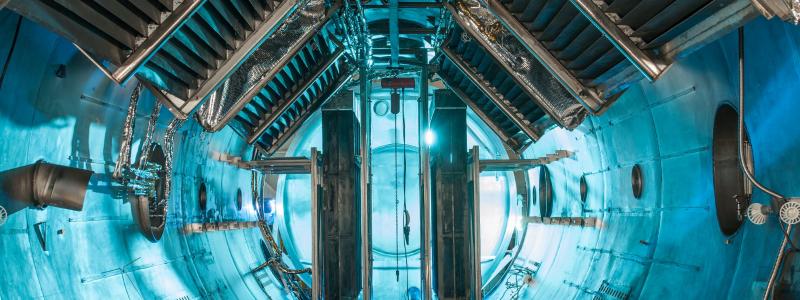What materials are tough, flexible, resistant to chemical change, and able to withstand harsh environments and extreme temperatures?
Perfluoroalkoxides, or PFA plastics, is a material with these resilient, high-performing properties. Useful in tubing and fluid processing, PFAs are commonly found in a variety of applications from health care to space travel.
For many years, Dr. Chadron M. Friesen has been part of the ongoing work to develop new and more environmentally friendly ways of producing PFAs.
Although PFA plastics are favoured for their chemical resistance and overall flexibility — forming and stabilizing PFAs, however, has been historically challenging. For many years, Dr. Chadron M. Friesen has been part of the ongoing work to develop new and more environmentally friendly ways of producing PFAs.
Breakthroughs in research
In 2015, Dr. Friesen and his research team paved the way with groundbreaking work in non-metal PFAs (CnF2nO-NR4+) derived from hydrofluoroethers (HFEs) — organic solvents that are non-ozone-depleting and have relatively low global warming impact.
Dr. Chadron M. Friesen has received a significant grant from the Natural Sciences and Engineering Research Council of Canada to develop innovative fluorine chemistries to impact bio-based aerospace materials and medical monitoring systems.
This progress continued, and in 2019, Dr. Friesen and his team reported the first use of silver(I) fluoride as a mild fluorination method to generate HFEs. Fluorination is usually considered a very difficult procedure to undertake because it requires very specialized equipment; however, Dr. Friesen and his team were able to add fluorine to molecules using very mild conditions.
In 2020, the team discovered an innovative use of PFAs for manufacturing high performance lubricating polymers known as perfluoropolyalkylethers (PFPAEs). In doing so, they were able to demonstrate that HFE can be used to make polymers. Prior to this work HFE was normally considered just a solvent or a heat transfer fluid (i.e. air conditioning fluid).
Developing new materials for theranostics and aerospace applications
Most recently in 2022, Dr. Friesen received a significant grant from the Natural Sciences and Engineering Research Council of Canada to develop new synthetic materials for use within diagnostic and therapeutic drug delivery devices (theranostics) and for applications in space missions.
Building upon his previous work, Dr. Friesen will be working to construct formally unobtainable molecules useful in building larger molecular chains (monomers). In the long-term, he will be working to develop new fluorination protocols derived from the naturally occurring ore, fluorospar (CaF2), which will improve medical materials and bio-based aerospace materials.
His work will benefit the fluoropolymer industry, which is looking for monomers that can be readily incorporated into biodegradable polymers—with the result of enhancing the material’s temperature performance but yet maintaining its environmental degradation. Dr. Friesen’s work in synthesizing aryl-HFE PFAs supports the production of unique aromatic terminated polymers suitable for protective coatings, surfactants, and in the reuse of discarded plastics.
Within the field of heath care, these materials can also be used to create polymeric tools for patient care applications, for example, in drug delivery devices and the production of lipophilic or fat-soluble drugs. New methods in specified, rapid late-stage fluorination methods are beneficial for yield improvements (i.e PET imagining drugs) and lowering the cost of production for lipophilic drugs.
Pursuing the next frontier of industry chemistry
Furthermore, the aerospace industry is pushing the boundaries of space exploration and the reusability of rocket transport. New materials are required to handle these newer demands. Due to the vastly different environments of outer space, some of the aerospace applications require chemical reactions to occur without solvent, heat, and gravity. The introduction of aromatic terminated PFPFAEs within biopolymeric blends using mechanochemical processes can improve materials’ extreme temperature performance even under the unique conditions of a space mission.
At the same time, Dr. Friesen is mentoring the next generation of industry chemists as they work alongside him in this research. Dr. Friesen anticipates that in the next five years, he and his team will develop innovative fluorine chemistries to impact bio-based aerospace materials and medical monitoring systems.
About Trinity Western University
Founded in 1962, Trinity Western University is a global Christian liberal arts university. We are dedicated to equipping students to discover meaningful connections between career, life, and the needs of the world. Drawing upon the riches of the Christian tradition, seeking to unite faith and reason through teaching and scholarship, Trinity Western University is a degree-granting research institution offering liberal arts and sciences as well as professional schools in business, nursing, education, human kinetics, graduate studies, and arts, media, and culture. It has four locations in Canada: Langley, Richmond-Lansdowne, Richmond-Minoru, and Ottawa. Learn more at www.twu.ca or follow us on Instagram @trinitywestern, Twitter @TrinityWestern, on Facebook and LinkedIn.
For media inquiries, please contact: media@twu.ca.
Photo by NASA on Unsplash.

